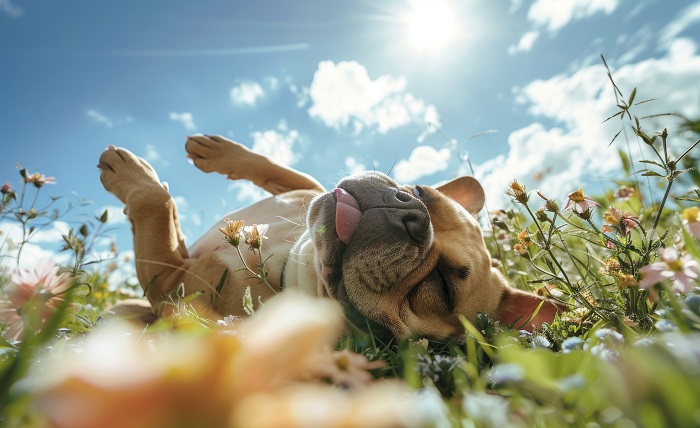Spring Pet Allergies in Wood Oaks Park: Vet Guide

Spring mornings in Wood Oaks Park are pure magic—live oaks stretching their ancient arms, azaleas painting neighborhoods in pink and white, and that perfect weather that makes you want to walk your dog twice as long. But if your furry companion starts acting like they’ve been rolling in poison ivy, you might be dealing with something more than just spring fever. Pet allergies and local treatment options become a real concern when pollen counts soar and your four-legged friend can’t stop scratching.
You know what’s wild? That gorgeous yellow dust coating your car isn’t just annoying for humans—it’s creating a seasonal nightmare for pets across our neighborhood. One day your dog’s happily sniffing around the park trails, and the next they’re pawing at their ears like there’s a marching band inside.
What’s Actually Floating Around Our Air?
Wood Oaks Park sits right in the heart of South Carolina’s pollen paradise. Those majestic live oaks we all love? They’re pollen powerhouses, especially from March through May. Add in the blooming azaleas, Bradford pears, and the general coastal humidity that keeps everything moist and moldy, and you’ve got a perfect storm for pet allergies.
The Lowcountry’s unique climate doesn’t help either. High humidity means mold spores stick around longer, and our mild winters mean allergens never really get that hard freeze reset that other regions enjoy. Local landscaping practices—think frequent fertilizing and those immaculate lawns—can introduce additional irritants that sensitive pets pick up on their paws and fur.
Ever notice how your pet’s fur seems magnetically attracted to that yellow dust coating everything? That’s not your imagination—pet hair is basically a pollen magnet during peak season.
When Your Pet’s Acting Strange (And It’s Not Just Attitude)
Spring allergies show up in ways that might surprise you. Sure, there’s the obvious scratching and red, irritated skin, but pets get creative with their discomfort. Constant paw licking becomes their new hobby. They might shake their heads obsessively or develop mysterious hot spots seemingly overnight.
Some pets get watery, gunky eyes that make them look perpetually sad. Others start sneezing or coughing like they’ve caught a cold that won’t quit. The tricky part? Behavioral changes can signal allergies too. A normally social dog might become grumpy and withdrawn, or an active cat suddenly wants to hide under the bed all day.
Here’s the thing that catches many pet parents off guard—ear infections love to tag along with seasonal allergies. That head shaking and ear scratching isn’t always just itchiness; it could be a secondary infection brewing. Same goes for skin problems that start as simple irritation but escalate when bacteria decides to join the party.
Red Flags That Mean Don’t Wait
Sometimes what starts as innocent spring sniffles turns into something that needs immediate attention. If your pet develops open sores from scratching, has trouble breathing, or shows signs of severe swelling around the face or throat, that’s not a “wait and see” situation.
Constant shaking, blood in discharge from ears or eyes, or a pet that suddenly won’t eat or drink needs same-day veterinary care. Nobody wants to see their companion suffer through a beautiful spring day because allergies spiraled into something more serious.
The reality is that untreated allergies often create openings for secondary infections. What could have been managed with proper treatment becomes a bigger, more uncomfortable problem for everyone involved.
Your Wood Oaks Park Survival Strategy
Living with a spring-allergic pet doesn’t mean staying indoors until summer. After walks around our neighborhood’s wooded areas, wipe down paws and fur with a damp cloth—it’s amazing how much pollen you’ll remove. Skip those early morning and late afternoon walks when pollen counts peak, usually around 5-10 AM and 3-7 PM.
Keep windows closed on high pollen days and run air purifiers if you have them. Regular baths help, but don’t overdo it—too much bathing strips natural oils and can make skin irritation worse. A good rule of thumb is weekly during peak allergy season, using lukewarm water and gentle, pet-specific shampoos.
Check and clean ears regularly. Pollen loves to hide in those furry ear canals, and catching problems early beats dealing with full-blown infections later. Yes, it’s extra work during the most beautiful weather of the year, but it beats midnight ear-scratching symphonies keeping everyone awake.
When Professional Help Makes All the Difference
Sometimes home management isn’t enough, and that’s perfectly normal. Veterinary professionals can distinguish between environmental allergies, food sensitivities, and other skin conditions that look similar but need different approaches. They might recommend antihistamines, medicated shampoos, or other treatments tailored specifically to your pet’s needs and severity of symptoms.
Coastal Creek Animal Hospital provides same-day appointments for pet allergy concerns, recognizing that spring allergies don’t follow convenient schedules. Professional diagnosis beats guessing games with internet remedies that might not address the actual problem.
The goal isn’t just managing symptoms—it’s helping pets enjoy spring as much as their humans do. With proper care and attention, even allergy-prone pets can have comfortable, happy springs in our beautiful Wood Oaks Park neighborhood.
Spring should be about longer walks, open windows, and watching your pet discover new smells and sights. A few proactive steps and knowing when to seek professional help means everyone can enjoy the season that makes living in South Carolina so special.




